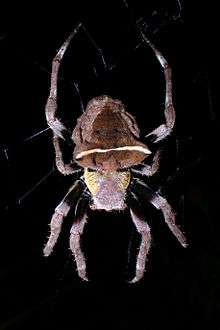Parawixia dehaani
Parawixia dehaani, known in Australia as the abandoned-web orb-weaver, is a species of orb weaver spider from the family Araneidae which is widely distributed in Australasia and eastern Asia.[1] It is common in gardens, leading to it sometimes being known by the name common garden spider.[2] The specific name is sometimes spelt dehaanii.[1]
| Parawixia dehaani | |
|---|---|
 | |
| Female | |
| Scientific classification | |
| Kingdom: | Animalia |
| Phylum: | Arthropoda |
| Subphylum: | Chelicerata |
| Class: | Arachnida |
| Order: | Araneae |
| Infraorder: | Araneomorphae |
| Family: | Araneidae |
| Genus: | Parawixia |
| Species: | P. dehaani |
| Binomial name | |
| Parawixia dehaani (Doleschall, 1859)[1] | |
| Synonyms[1] | |
| |
Description
The female Parawixia dehaani is a large, dark brown spider with variable patterns on the abdomen. The most noticeable field characteristic is the triangular abdomen having corners with sharp spikes.[3]
Distribution
The species is found from India to the Philippines, New Guinea[1] and Australia.[4] It has also been recorded in Pakistan.[5]
Habitat
Parawixia dehaani is found in gardens, disturbed areas and nearby bushland.[4]
Biology
Parawaixia dehaani is nocturnal and feeds mainly on moths. During the day the spider shelters under a leaf in the vegetation.[2] It builds a vertical orb web with an open hub, which often looks damaged, with sections missing, hence the Australian common name, abandoned-web orb-weaver.[4] When disturbed the spiders falls to the ground and plays dead with its legs retracted.[4] Bats have been recorded as being captured by this spider.[6]
References
- "Parawixia dehaani (Doleschall, 1859)". Natural History Museum Bern. Retrieved 18 September 2016.
- "Common Garden Spider Parawixia dehaani (Doleschall) 1859". Joseph K H Koh. Retrieved 18 September 2016.
- "South Indian Spiders". Division of Arachnology, Dept of Zoology, Sacred Heart College, Thevara, Kochi, Kerala, India. Retrieved 18 September 2016.
- "Parawixia dehaanii (Doleschall 1859) Abandoned-web Orb Weaver". Robert Whyte and Dr Greg Anderson. Retrieved 18 September 2016.
- Mukhtar, Muhammad Khalid; Shafaat, Yar Khan; Jabeen, Sidra; Tahir, Hafiz Muhammad; Qadir, Abdul; Raees Ahmad, Khawaja; Butt3, Abida; Arshad, Muhammad (2012). "A Preliminary Checklist of the Spider Fauna of Sargodha (Punjab), Pakistan". Pakistan J. Zool. 44 (5): 1245–1254.
- Nyffeler, M.; Knörnschild, M. (2013). "Bat Predation by Spiders". PLoS ONE. 8 (3): e58120. doi:10.1371/journal.pone.0058120. PMC 3596325. PMID 23516436.